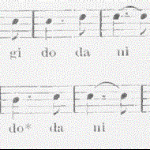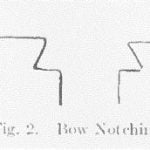Hunting was pursued by the men either singly or in bands. While the attendance upon the crops kept them at home much of the time, there were seasons of comparative idleness during which parties set off on the hunt. The flesh of nearly all the mammals and birds of their habitat was eaten by the Yuchi with the exception of such as were sacred for ceremonial purposes or were protected by some taboo. The chief game animals hunted by them for their flesh were the deer, weeyan’, bison, wedingá, bear, sagee’, raccoon, djatyAn’, opossimi, WAtsagowAn’, rabbit, cádjwané, squirrel, cayá; while those whose skins were chiefly sought after were the panther, weiceAn’, wildcat, poci’, fox, cadeané, wolf, dalá, otter, culané, beaver, cag n’, and skunk, yuseAn’. The flesh of these was also eaten at times. Wild turkeys, wctcea’, quail, spans i’, partridge, ducks, geese and other birds were continually hunted for food.
The game animals were believed to be very cunning and wise in knowing how to avoid being captured. So in order to blind their senses, and to over-come their guardian spirits, the magic power of certain song burdens was employed by hunters. Shamans held these formulas in their possession and could be induced to accompany the hunting party to the field to aid in the bewitching of the quarry. Shamans might also teach the formula to some one for the same purpose, upon the payment of some price or upon being promised a share in the spoils.
One of these songs used for charming the deer is.

The syllables gi do are sometimes given three times, sometimes four, with no seeming regularity.
Not only had the hunter himself to be careful to keep the game animals and supernatural protectors well disposed toward him by observing all the taboos. But those connected with him in any way had to be careful too. This was particularly true in regard to his wife. Her main care was to remain faithful in her husband’s absence, no matter how long he might be away. Any remissness on her part would cause his guiding spirit to leave him and then his hunt would turn out unsuccessful.
Besides these magic aids the Yuchi made use of more material means to bring down game. The bow and arrow and blowgun were the chief hunting implements, while a kind of deer call was carried on a string about the neck to call the bucks during the rutting season and the does when they were rearing their fawns.

The bow, cstade’, is a single almost straight stave of bois d’arc (Toxylon pomijcrum) or Osage Orange, about five feet in length. Sassafras and hickory bows were sometimes made. No backing of sinew is known to have been used. The stave is broadest in the middle, where it is about one and one-half inches in width, tapering to one inch at the ends. The thickness of the stave is about three-quarters of an inch. The rich dark color of the wood is brought out by greasing. In section the bow is almost rectangular. The ends are cut out into little knobs of several shapes (Fig. 2) to hold the string. The bow string is made of deer sinew, yAnhi’, or strips of rawhide twisted tightly. Squirrel skins are much in use for bow strings. The skin is cut around the edge spirally toward the center, thus giving a single long strip. As extra strength is desired, four such strips are twisted together, forming quite a thick cord. A guard, gonsäfané, of leather is used by archers to protect the wrist from the bow string when this is released. The guard is bound on by two thongs attached to holes in the leather (Fig. 3).

Arrows, la cu’, for hunting are made of the straight twigs of arrow-wood or of cane stalks of the proper thickness (Fig. 4). In the former case it was only necessary to scrape off the bark and season the twigs. The Yuchi do not seem to have had the idea of the fore-shaft. The point, lacipá, which was formerly of stone is nowadays made of iron and is bound by means of sinew into a split in the shaft (Fig. 4). The arrows are feathered prefer-ably with hawk feathers, as the Indians believe the hawk to be swift and sure in its flight. Turkey tail feathers are much used also. The split plumes, two in number, are bound to the shaft at both ends with sinew. One side of the feather is shaved clean of ribs up to within an inch of the outer end. The lower or base end of the quill is then lashed on [flat].The outer end is turned down and the turned down length is lashed on. In this way an ingenious twist is given to the feather, which causes the arrow to revolve in its flight, acting on the principle of the rifled bullet (Fig. 4, d). There is some diversity in the length of the arrow shaft and in the size of the arrow head. For killing large game and in warfare the shafts used are almost three feet long with iron triangular arrow heads. But in hunting small game they have simple round sharpened shafts which are seasoned in heat to make them stiff (Fig. 4, b). The arrows used for shooting fish are somewhat different from the ones described above, as we shall see. Blunt wooden-headed arrows, so common everywhere, were also used for stunning small animals and birds (Fig. 4, c).

The arrow shaft in all cases is cylindrical, and of the same width through-out. In some specimens, however, there is a slight widening at the notch to give a better grip. Several instances were also noticed where there were two notches at right angles to each other. This feature, according to the native idea, makes it possible for the shooter to send his arrow so that the iron point is either vertical or horizontal. In the former case the point passes more readily between the ribs of deer, bison and other animals, while in the latter case it is designed to pass between the ribs of man. The double notching also facilitates adjustment in rapid shooting. An old arrow, one that has seen use, is thought to shoot better and to be more effective in general than a new one. In shooting with the bow it is held nearly vertically, the release to the string being given by the index finger, between the third joint of which and the thumb the butt of arrow is grasped. The release, in general terms, comes nearest to that described by Mason as the tertiary release. 1
One form of the blowgun, which is obsolete now, was, according to memory, made of a cane stalk with the pith removed. It was between five and a half and six feet long. The darts were made of hard wood, the points being charred and sharpened. A tuft of cotton wrapped about the end of the dart like a wad formed the piston. This was almost exclusively used for bringing down small animals, squirrels and birds.
Another part of the former hunter’s outfit was, frequently, a stuffed deer head which he put over his shoulders or elevated on a stick in front of him when he was approaching the deer. Thus disguised he could be surer of getting a favorable shot. The formula given above was sung at intervals during this process of getting nearer.

Dogs, tsené, have always been the invariable companions of the hunters, whether alone or in bands, their principal office being to track game and hold it at bay. The present Indian dogs are mongrels showing intemixture with every imaginable strain, but the wolfish appearance and habits of many of them would suggest that their semi-domestic ancestors were of the wolf breed.
Hunters are usually proficient in calling wild turkey’s by several means. One instrument made for this purpose is the hollow secondary wing bone of the turkey, about five inches in length. The hunter draws in his breath through this tube, making a noise which can best be described as a combination of smacking, squeaking and sucking. By skillfully operating the calls the birds are lured within range. Sometimes the palm of the hand is employed in making the noise. Another device is to grate a piece of stone on the top of a nail driven fast into a piece of wood. The rasping sound produced in this way will answer quite effectively as a turkey call if manipulated with skill.
The Yuchi do not seem to have used the deer fence so common in many parts of America. They have been known, however, to employ a method of driving game from its shelter to places where hunters were stationed, by means of fire. Grassy prairies were ignited and when the frightened animals fled to water they were secured by the band of hunters who were posted there.
The deer call, weeyAnkané, mentioned before, which is used in calling deer within range, is a rather complex instrument and probably a borrowed one, at least in its present form (Fig. 5). A hollow horn is fitted with a wooden mouthpiece which contains a small brass vibrating tongue. When blown this gives a rather shrill but weak sound which can be modified greatly by blowing softly or violently. A tremulous tone like the cry of a fawn is made by moving the palm of the hand over the opening of the horn. Much individual skill is shown by the hunters in using this instrument.
Citations:

